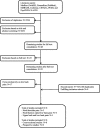Physical risk factors for adolescent neck and mid back pain: a systematic review
- PMID: 30258567
- PMCID: PMC6151922
- DOI: 10.1186/s12998-018-0206-y
Physical risk factors for adolescent neck and mid back pain: a systematic review
Abstract
Background: Besides low back pain (LBP), also neck pain (NP) and mid back pain (MBP) are common health issues in adolescence. Psychological factors are regarded as main risk factors for spinal pain in adolescence, but recent studies suggest that the importance of physical factors might be underestimated. The purpose of this study was to summarize the results of studies on physical risk factors for adolescent NP and MBP.
Methods: Cross-sectional and prospective English studies on NP and MBP in adolescents aged 10 to 18 were searched by a professional librarian in Medline (OvidSP), Premedline (PubMed), EMBASE, Cochrane, CINAHL, PEDro and PsycINFO up to October 2016. Studies that were restricted to self-report via questionnaires were excluded.
Results: Eight cross-sectional studies could be included in this review. Some aspects of sagittal alignment in sitting (increased lumbar lordosis) and standing (anteroposition of the head, sway-back posture) were associated with NP. Study comparability was impeded by inconsistent definitions of NP and MBP and a wide variety of outcome measures.
Conclusions: This systematic review indicates that prospective studies using a consistent definition of NP and MBP are needed. Such studies might further investigate sagittal alignment in sitting and standing as possible risk factors for NP and MBP in adolescence using a consistent terminology for the outcomes and longitudinal research designs.
Keywords: Adolescent; Mid back pain; Neck pain; Systematic review.
Conflict of interest statement
Not applicable.Not applicable.The authors declare that they have no competing interests.Springer Nature remains neutral with regard to jurisdictional claims in published maps and institutional affiliations.
Figures
Similar articles
-
Sagittal standing posture and its association with spinal pain: a school-based epidemiological study of 1196 Flemish adolescents before age at peak height velocity.Spine (Phila Pa 1976). 2012 Sep 1;37(19):1657-66. doi: 10.1097/BRS.0b013e3182408053. Spine (Phila Pa 1976). 2012. PMID: 22108378
-
A systematic review on quantifiable physical risk factors for non-specific adolescent low back pain.J Pediatr Rehabil Med. 2018;11(2):79-94. doi: 10.3233/PRM-170526. J Pediatr Rehabil Med. 2018. PMID: 30010152
-
Multivariable modeling of factors associated with spinal pain in young adolescence.Eur Spine J. 2016 Sep;25(9):2809-21. doi: 10.1007/s00586-016-4629-7. Epub 2016 Jun 8. Eur Spine J. 2016. PMID: 27278392
-
The prevalence of neck-shoulder pain, back pain and psychological symptoms in association with daytime sleepiness - a prospective follow-up study of school children aged 10 to 15.Scand J Pain. 2018 Jul 26;18(3):389-397. doi: 10.1515/sjpain-2017-0166. Scand J Pain. 2018. PMID: 29794264
-
Association between objectively measured physical behaviour and neck- and/or low back pain: A systematic review.Eur J Pain. 2020 Jul;24(6):1007-1022. doi: 10.1002/ejp.1551. Epub 2020 Mar 26. Eur J Pain. 2020. PMID: 32096285
Cited by
-
Headache and musculoskeletal pain in school children are associated with uncorrected vision problems and need for glasses: a case-control study.Sci Rep. 2021 Jan 22;11(1):2093. doi: 10.1038/s41598-021-81497-w. Sci Rep. 2021. PMID: 33483534 Free PMC article.
-
Risk factors for non-specific neck pain in young adults. A systematic review.BMC Musculoskelet Disord. 2020 Jun 9;21(1):366. doi: 10.1186/s12891-020-03379-y. BMC Musculoskelet Disord. 2020. PMID: 32517732 Free PMC article.
-
Risk factors for neck pain in college students: a systematic review and meta-analysis.BMC Public Health. 2023 Aug 8;23(1):1502. doi: 10.1186/s12889-023-16212-7. BMC Public Health. 2023. PMID: 37553622 Free PMC article.
-
Physical measures of physical functioning as prognostic factors in predicting outcomes for neck and thoracic pain: Protocol for a systematic review.PLoS One. 2025 Jan 24;20(1):e0316827. doi: 10.1371/journal.pone.0316827. eCollection 2025. PLoS One. 2025. PMID: 39854374 Free PMC article.
-
Neck pain and associated factors in a sample of high school students in the city of Bauru, São Paulo, Brazil: cross-sectional study.Sao Paulo Med J. 2021 Jan-Feb;139(1):38-45. doi: 10.1590/1516-3180.2020.0168.R1.30102020. Sao Paulo Med J. 2021. PMID: 33656126 Free PMC article.
References
Publication types
MeSH terms
LinkOut - more resources
Full Text Sources
Other Literature Sources
Medical
Miscellaneous


